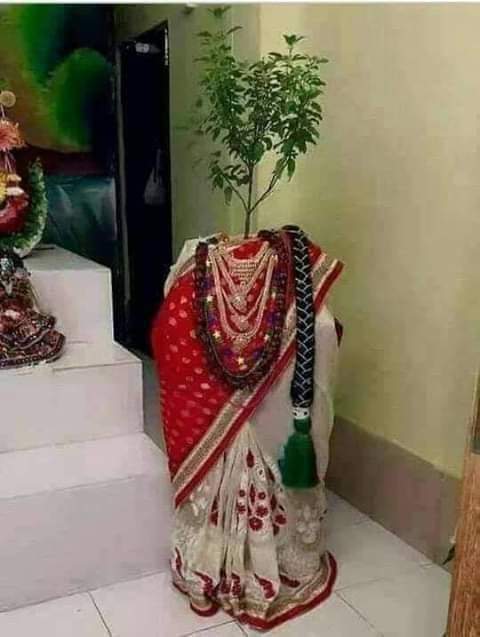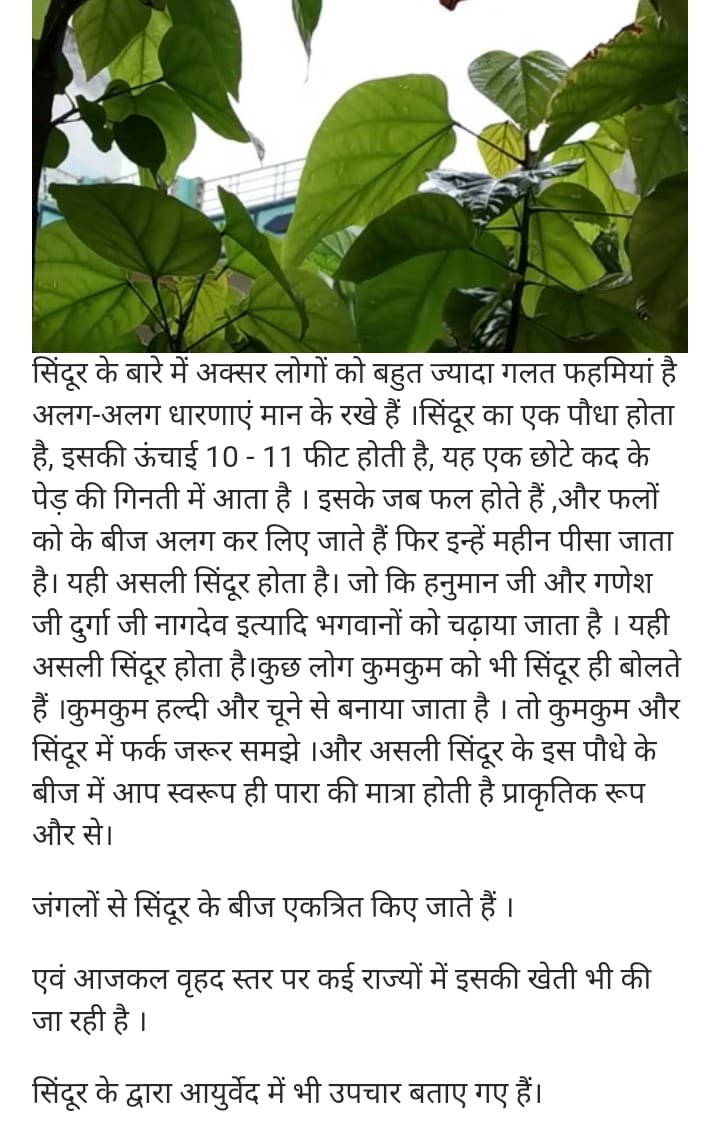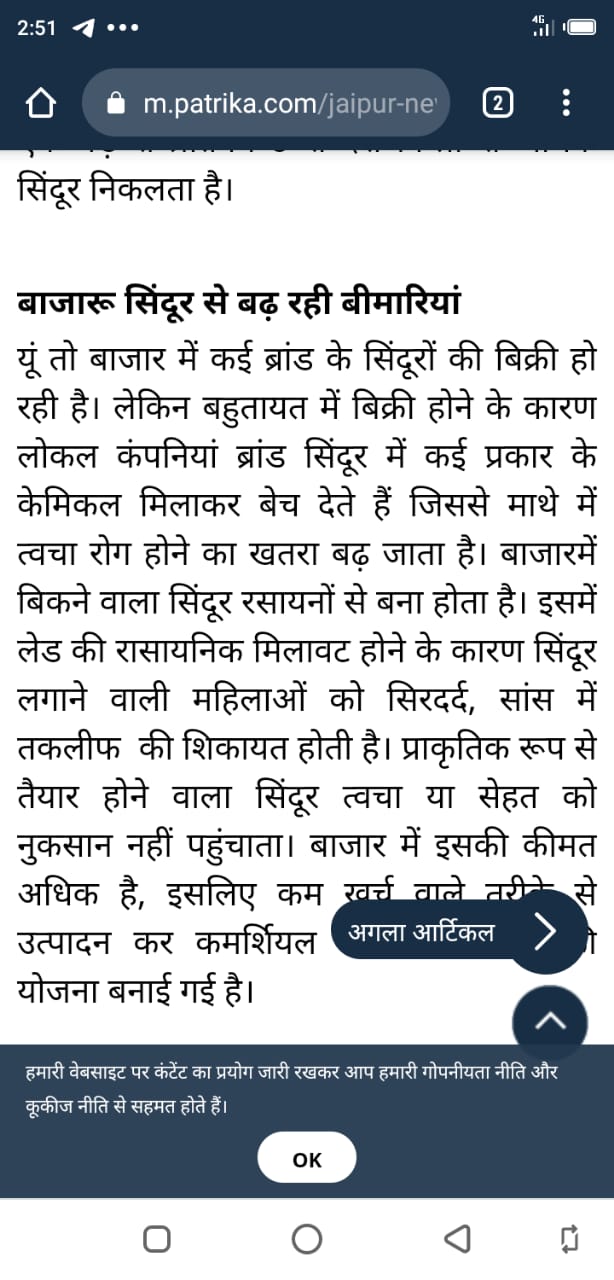https://www.newsgram.com/sacred-trees-in-hinduism/
Trees give us shade, fruits, wood, oxygen, shelter, fragrance, medicines, sap, flowers, leaves, etc. They also prevent erosion near water bodies. But trees can also be sacred, according to religious beliefs.
Bhagwad Gita chapter three verse 14 says--Plant food is the core life support for humanity and rain is the core life support for trees.
Matsaya puran 154:512 says that one tree is equal to ten children, 100 lakes, 1000 ponds, and 10,000 wells.
Aranyani is the mother of forests (including trees and animals) as per tenth mandal of Rig Veda.
Some trees are considered sacred in Hinduism. Many of these are big, have a long life, and provide many things to humans and have folklore associated with them.
Tulsi
It is also known by the name of Haripriya or Vishnupriya or Shripriya.
It is usually planted and grown in front or center of a Hindu house and the structure around it is called Tulsi Vrindavan. Tulsi plant is considered very auspicious. Tulsi Vivah is celebrated between Prabodhini Ekadasi and Kartik Purnima. Its leaves are used in puja and offered to Vishnu Bhagwan.
It is used in making tea, tulsi water, and jap mala or tulsi mala.
This plant is useful in the treatment of cough, cold, muscle aches, gout, rheumatic arthritis, and insect bites.
Banyan
Just to clarify, banyan tree is not banana tree. In Hindi it is called argad. It is also known by the name of Strangler Fig or Nyagrodha.
One indestructible Banyan tree is in Prayag and is called Akshya Vat. Another is in Gaya, Bihar, and one is in Varanasi. It is the national tree of India.
This tree’s roots and branches grow over a very large area and it has a very long life. The roots and branches can grow in fissures of stones, concrete, walls of building, etc. The roots even grow upwards and connect to branches to give them support. This tree usually grows on or around a host e.g. other tree, and eventually destroys that host tree, building, stone, etc. Nothing grows under its shade. Initially they need a lot of water, but when fully grown they can live without water for a long time.
The Great Banyan tree in the Indian Botanic Garden is the largest Banyan tree. It has many aerial roots and looks like a forest.

Bargad tree provides a lot of shade to temples, homes, shops, and pedestrians. People sit down under its shade and hold meetings, discussions, etc. Rishis and sadhus sit down under this tree and meditate. Women offer prayers to this tree and ask for a long married life on Vat Savitri Purnima.
This tree is used to treat skin diseases, female infertility, to stop bleeding, diarrhea, joint pain, tooth ache, etc. Milk sap is used to polish brass utensils. Sap is also used as an adhesive and polish.
Peepal
Also called fig, Bodhi, and ashvat. It is considered to be the king of trees. Mahavir Buddh got enlightenment under a Peepal tree and Bhagwan Krishn left his human body under a peepal tree.
It keeps growing as it ages, its branches hang down, its roots grow very deep inside the earth, and it has a very long life. Rishis and sadhus meditate under its shade. In the morning people do seven pradakshinas around this tree.
Its medicinal use is in treatment of asthma, diabetes, epilepsy, gastrointestinal upset, and wounds.
Ashok
‘Shok’ means sorrow or grief. Ashok means no sorrow or grief.
This tree has a zillion names. Some are- sita-ashoka, anganpriya, ashopalav, asupala, apashaka, hemapushp, kankeli, madhupushp, pindapushp, pindipushp, vanjula, vishoka, and vichitra. It is found in rain forest and its flowers are red and yellow. Its fruit contain multiple seeds. Lots of folklore is associated with this tree. Ravan kept Sitaji in Ashok Vatika.
It is used to treat depression and infertility.
There is one other tree which resembles the Ashok tree. It is called false Ashok tree. Its flowers are green in color, its fruit has only one seed, and it is taller than the Ashok tree.
Parijaat
It is in Kintoor, near Barabanki in U.P. It is also known as kalpvriksh.
It is believed that Krishn brought this tree to earth from Indralok and it is more than a thousand years old. There are many stories associated with this tree.
It grows flowers, but not fruit or seeds, so more parijaat trees cannot grow.
Sandalwood or Chandan
It has a very nice and unique fragrance and its powder or paste form is used for tilak. It is also used to make agarbatti, soap, and in aroma therapy. Its wood is used in temple construction. The wood retains its fragrance for many years. Oil is also extracted from wood.
Jains, Buddhs, Sufis, Zoroastrians, Chinese, and Japanese also use sandalwood.
It is grown in India, Sri Lanka, Indonesia, Malaysia, Philippines, and Australia.
It is used to treat cold, bronchitis, skin, liver, gallbladder, urinary tract and heart diseases, general weakness, fever.
Kalpvriksh
Also called kalptaru, kalpdrup, kalpadapa, surtaru, devtaru, and kalplata. It is the wish fulfilling tree.
It appeared during samundra manthan. Indra Devta took it to Devlok and planted it in Surkanan Van.
There are five Kalpvriksh in Devlok — Banyan, Parijat, Mandana, Santana, and Harichandan. On Earth, banyan tree, coconut tree, ashvatta or sacred fig tree, mahua, shami, chyur or indian butter tree, and kalplatha are considered kalpvriksh. Jains believe that there are 10 kalpvriksha and Buddists believe that there is one kalpvriksh.
Bael
Also known as shivadruma or shriphal. Its branches are straight. Its leaves grow in a group of three, have a very sweet fragrance, and are called belpatra.
The leaves have anti inflammatory and antioxidant properties and are used for protecting stomach and controlling cholesterol.
Bael leaves are offered to Shivji. Its fruit is called Bilva, and is like wood from outside, and therefore this tree is also called wood apple tree.
It grows in dry climate and is usually grown in temple gardens.
It is used as a laxative, tonic, and in treatment of diabetes and hemorrhoids. It has antibiotic and antiemetic properties.
Neem
It is also called healing tree, and is drought resistant. Its leaves are offered to Shivji. Dried leaves are used to protect clothes from insects.
Neem tree has antibacterial, antiviral, and antifungal properties. It is used for skin diseases and to treat diabetes. Its twigs are used to clean teeth. Smoke made by burning neem leaves makes bees, insects, etc. fly away.
Its fruit is called nimboli. Neem is eaten on the occasions of Ugadi and Gudi Padva.
Coconut
Coconuts are offered during arti and prayers and are broken on auspicious occasions. Copra or dried water is used to make oil, husk or coir is used to make ropes, the white part is eaten, and the brown shell is used as wood to make boats. Its flowers give sugar.
Mango
leaves are used for auspiciousness and offered to Saraswati Devi. They are also used in hawan.
Banana leaves are offered to Laxmi Devi and Vishnu Bhagwan and also used as plates. Fruit is offered as Prasad.
Bamboo is used to make Bansuri.
Sami
The leaves are offered to Ram Bhagwan and are used to treat leprosy and intestinal diseases and have anti-inflammatory properties. Its roots are used in diarrhea and dysentery.
Flowers are used to prevent miscarriage and pods to treat urological diseases. Sami tree can grow in adverse climate and its roots go very deep into the soil.
Its leaves remain green even in drought.
Jackfruit tree or Kathal
It has a unique aroma. Its pulp gives a mixed smell of pineapple and banana. It is the largest fruit in the world and has multiple seeds in one fruit. Wood is used to make musical instruments e.g. veena, mridangam, thimila and kanjira. It is also used to make furniture, doors, windows, and roofs.
The sacred Jackfruit tree site is on Kaina Hill of Bhashmukh parvat in Manipur. Seven Krishna images were carved from this tree and then placed in different temples.
Trees are not considered sacred and prayers are not offered to them in Sikhism, Islam, Christianity, and Judaism, but they are mentioned for their benefits in Bible and Quran. Jews have some rules and guidelines to follow before cutting trees, particularly fruit bearing trees.
There is a Gurudwara known by the name Shree Ber Sahib. Sikhs believe that Guru Nanak Dev sat down and meditated for more than 14 years under a Ber tree near this gurudwara.There are three Ber trees in Golden Temple, Amritsar—Dukhbhanjan Beri, Ber Baba Budha Sahib, and Lachi Ber.
Some trees mentioned in Quran are the date, palm, fig, olive, pomegranate, and tamarisk. Tuba is like Kalpvriksh.
Trees mentioned in the Bible are almond, apple, date (khajoor), palm (devdar in Hindi), fig (anjir in Hindi), oak (baloot), pine, tamarisk (jhaoo or farash or jhambook) , pomegranate, walnut, acasia (babul).
Druits and Celts—alder, apple, ash, birch, blackthorn, cedar, elder, elm, fir, hazel, holly, juniper, mistletoe, oak, pine, rovan, willow, yew.
Nine sacred trees to build a bonfire in Wiccan tradition are birch, rowen, ash, adler, willow, hawthorn, oak, holly, and hazel.
General Sherman is the largest tree in the world, by volume. It is located in Sequoia National Park, California, U.S.A.
https://allthatsinteresting.com/oldest-tree-in-the-world-methuselah-tree
Read more at: https://www.newsgram.com/sacred-trees-in-hinduism
Vriksh Ayurved is a branch of medicine which deals with the planting, harvest, irrigation, diseases, growth, wellbeing etc. of plants. It has twelve chapters.
- 1st chapter: Bhoomi Nirupana which explains types of soils, properties of different types of soils, water requirements, fertility, etc.
- 2nd chapter: Bijopativithi explains gradation and preservation of seeds and also how to maintain the properties and potential of seeds.
- 3rd chapter: Padapavivaksha explains the biology of many trees, its anatomy, mechanisms, and functioning.
- 4th chapter: Roopana vidana explains the plant senses and its reactions to external stimuli.
- 5th chapter: Niscana vidhi explains the methods and techniques of irrigation according to environment.
- 6th chapter: Poshana vidhi explains the fertilization gechniques and ways to nurture the plants.
- 7th chapter: Drumaraksha explains the techniques to protects the trees in adverse environmental conditions and fixing the damage to trees caused by extreme weather.
- 8th chapter: Taru chikitsa explains the protection from pests and treatment of infestations.
- 9th chapter: Upavana kriya explains organization, preservation, and cultivation of home gardens.
- 10th chapter: Nivasanna taru explains the benefits, harms, and dangers of various plants and trees.
- 11th chapter: Chitrikarana explains the hybrid techniques. It has methods to artificial infuse properties of one plant in another.
- 12th chapter: Taru mahima explains the importatance of taking care of trees and their preservation.
I feel like plants are more evolved than us. They appear to be meditating, taking mimimal stuff from outside-just for they needs, giving a lot to everyone. They are stable and happy- sthir sukham asanam sthiti of Rishi Patanjali. They grow up like energy goes up in chakras. They seem to be in Samadhi. They have no attachments, their seeds go far away from them.
Bharti Raizada
Whatsapp forward:
*पीपल
💚अकेला ऐसा पौधा जो दिन और रात दोनो समय आक्सीजन देता है l
💛पीपल के ताजा 6-7 पत्ते लेकर 400 ग्राम पानी में डालकर 100 ग्राम रहने तक उबालें ,ब्रर्तन एल्यूमीनियम का नहीं हो, आपका ह्रदय एक ही दिन में ठीक होना शुरू हो जाएगा ।
💛पीपल के पत्तों पर भोजन करें , लीवर ठीक हो जाता है ।
💛पीपल के सूखे पत्तों का पाउडर बनाकर आधा चम्मच गुड़ में मिलाकर सुबह दोपहर शाम खायेँ, किंतना भी पुराना दमा ठीक कर देता है ।
💛पीपल के ताजा 4-5 पत्ते लेकर पीसकर पानी में मिलाकर 1- 2 बार में ही पीलिया में आराम देना शुरू कर देता है ।
💛पीपल की छाल को गंगाजल में घिसकर घाव में लगाये तुरंत आराम देता है ।
💛पीपल की छाल को खांड मिलाकर दिन में 5-6 बार चूसे, कोई भी नशा छूट जाता है ।
💛पीपल के पत्तों का काढ़ा पियें , फेफड़ों , दिल ,अमाशय और लीवर के सभी रोग ठीक कर देता है ।
💛पीपल के पत्तों का काढ़ा बनाकर पिये, किडनी के रोग ठीक कर देता है व पथरी को तोड़कर बाहर करता है ।
💛किंतना भी डिप्रेशन हो, पीपल के पेड़ के नीचे जाकर रोज 30 मिनट बैठिए डिप्रेशन खत्म कर देता है ।
💛पीपल की फल और ताजा कोपलें लेकर बराबर मात्रा में लेकर पीसकर सुखाकर खांड मिलाकर दिन में 2 बार लें , महिलाओं के गर्भशाय और मासिक समय के सभी रोग ठीक करता है ।
💛पीपल का फल और ताजा कोपलें लेकर बराबर मात्रा में पीसकर सुखाकर खांड मिलाकर दिन में 2 बार लें , बच्चों का तुतलाना ठीक कर देता है और दिमाग बहुत तेज करता है ।
💛जिन बच्चों में हाइपर एक्टिविटी होती है, जो बच्चे दिनभर रातभर दौड़ते भागते हैं सोते कम हैं , पीपल के पेड़ के नीचे बैठाइए ,सब ठीक कर देता है ।
💛किंतना भी पुराना घुटनों का दर्द हो, पीपल के नीचे बैठें 30-45 दिन में सब खत्म हो जाएगा ।
💛शरीर में कहीं से भी खून आये, महिलाओं को मासिक समय में रक्त अधिक आता हो, बाबासीर में रक्त आता हो, दांत निकलवाने पर रक्त आये ,चोट लग जाये, 8-10 पत्ते पीसकर,छानकर पी जाएं, तुंरत रक्त का बहना बंद कर देता है ।
💛शरीर में कहीं भी सूजन हो, दर्द हो, पीपल के पत्तों को गर्म करके बांध दे, ठीक हो जायेगे ।
पुराणों व हिन्दू धर्मग्रंथों में उल्लेखित पर्यावरण ज्ञान
👉 10 कुॅंओं के बराबर एक बावड़ी, 10 बावड़ियों के बराबर एक तालाब, 10 तालाब के बराबर 1 पुत्र एवं 10 पुत्रों के बराबर एक वृक्ष है।
👉 जीवन में लगाए गए वृक्ष अगले जन्म में संतान के रूप में प्राप्त होते हैं। (विष्णु धर्मसूत्र 19/4)
👉 जो व्यक्ति पीपल अथवा नीम अथवा बरगद का एक, चिंचिड़ी (इमली) के 10, कपित्थ अथवा बिल्व अथवा ऑंवले के तीन और आम के पांच पेड़ लगाता है, वह *सब पापों से मुक्त हो जाता है। ( भविष्य पुराण)
👉 पौधारोपण करने वाले व्यक्ति की सभी मनोकामनाएं पूर्ण होती है।
👉 शास्त्रों के अनुसार पीपल का पेड़ लगाने से संतान लाभ होता है।
👉 अशोक वृक्ष लगाने से शोक नहीं होता है।
👉 पाकड़ का वृक्ष लगाने से उत्तम ज्ञान प्राप्त होता है।
👉 बिल्वपत्र का वृक्ष लगाने से व्यक्ति दीर्घायु होता है।
👉 वट वृक्ष लगाने से मोक्ष मिलता है।
👉 आम वृक्ष लगाने से कामना सिद्ध होती है।
👉 कदम्ब का वृक्षारोपण करने से विपुल लक्ष्मी की प्राप्त होती है।
प्राचीन भारतीय चिकित्सा- पद्धति के अनुसार पृथ्वी पर ऐसी कोई भी वनस्पति नहीं है, जो औषधि ना हो।
स्कंद पुराण में एक सुंदर श्लोक है-
अश्वत्थमेकम् पिचुमन्दमेकम्
न्यग्रोधमेकम् दश चिञ्चिणीकान्।
कपित्थबिल्वाऽऽमलकत्रयञ्च पञ्चाऽऽम्रमुप्त्वा नरकन्न पश्येत्।।
अश्वत्थः = पीपल (100% कार्बन डाइऑक्साइड सोखता है)
पिचुमन्दः = नीम (80% कार्बन डाइऑक्साइड सोखता है)
न्यग्रोधः = वटवृक्ष(80% कार्बन डाइऑक्साइड सोखता है)
चिञ्चिणी = इमली (80% कार्बन डाइऑक्साइड सोखता है)
कपित्थः = कविट (80% कार्बन डाइऑक्साइड सोखता है)
बिल्वः = बेल (85% कार्बन डाइऑक्साइड सोखता है)
आमलकः = आँवला (74% कार्बन डाइऑक्साइड सोखता है)
आम्रः = आम (70% कार्बन डाइऑक्साइड सोखता है)
(उप्ति = पौधा लगाना)
अर्थात्- जो कोई इन वृक्षों के पौधों का रोपण करेगा, उनकी देखभाल करेगा उसे नरक के दर्शन नही करना पड़ेंगे।
इस सीख का अनुसरण न करने के कारण हमें आज इस परिस्थिति के स्वरूप में नरक के दर्शन हो रहे हैं।
अभी भी कुछ बिगड़ा नही है, हम अभी भी अपनी गलती सुधार सकते हैं।
औऱ गुलमोहर, निलगिरी- जैसे वृक्ष अपने देश के पर्यावरण के लिए घातक हैं।
पश्चिमी देशों का अंधानुकरण कर हम ने अपना बड़ा नुकसान कर लिया है।
पीपल, बड और नीम जैसे वृक्ष रोपना बंद होने से सूखे की समस्या बढ़ रही है
ये सारे वृक्ष वातावरण में ऑक्सीजन की मात्रा बढ़ाते है साथ ही धरती के तापनाम को भी कम करते है।
हमने इन वृक्षों के पूजने की परंपरा को अन्धविश्वास मानकर फटाफट संस्कृति के चक्कर में इन वृक्षों से दूरी बनाकर यूकेलिप्टस (नीलगिरी) के वृक्ष सड़क के दोनों ओर लगाने की शुरूआत की। यूकेलिप्टस झट से बढ़ते है लेकिन ये वृक्ष दलदली जमीन को सुखाने के लिए लगाए जाते हैं। इन वृक्षों से धरती का जलस्तर घट जाता है। विगत ४० वर्षों में नीलगिरी के वृक्षों को बहुतायात में लगा कर पर्यावरण की हानि की गई है।
शास्त्रों में पीपल को वृक्षों का राजा कहा गया है।
मूले ब्रह्मा त्वचा विष्णु शाखा शंकरमेवच।
पत्रे पत्रे सर्वदेवायाम् वृक्ष राज्ञो नमोस्तुते।।
भावार्थ-जिस वृक्ष की जड़ में ब्रह्मा जी तने पर श्री हरि विष्णु जी एवं शाखाओं पर देव आदि देव महादेव भगवान शंकर जी का निवास है और उस वृक्ष के पत्ते पत्ते पर सभी देवताओं का वास है ऐसे वृक्षों के राजा पीपल को नमस्कार है।।
आगामी वर्षों में प्रत्येक ५०० मीटर के अंतर पर यदि एक एक पीपल, बड़ , नीम आदि का वृक्षारोपण किया जाएगा, तभी अपना भारत देश प्रदूषणमुक्त होगा।
घरों में तुलसी के पौधे लगाना होंगे।
हम अपने संगठित प्रयासों से ही अपने "भारत" को नैसर्गिक आपदा से बचा सकते है।
भविष्य में भरपूर मात्रा में नैसर्गिक ऑक्सीजन मिले इसके लिए आज से ही अभियान आरंभ करने की आवश्यकता है।
आइए हम पीपल, बड़, बेल, नीम, आंवला एवं आम आदि वृक्षों को लगाकर आने वाली पीढ़ी को निरोगी एवं "सुजलां सुफलां पर्यावरण" देने का प्रयत्न करें।
तुलसी कौन थी?
तुलसी(पौधा) पूर्व जन्म मे एक लड़की थी जिस का नाम वृंदा था, राक्षस कुल में उसका जन्म हुआ था बचपन से ही भगवान विष्णु की भक्त थी.बड़े ही प्रेम से भगवान की सेवा, पूजा किया करती थी.जब वह बड़ी हुई तो उनका विवाह राक्षस कुल में दानव राज जलंधर से हो गया। जलंधर समुद्र से उत्पन्न हुआ था.
वृंदा बड़ी ही पतिव्रता स्त्री थी सदा अपने पति की सेवा किया करती थी.
एक बार देवताओ और दानवों में युद्ध हुआ जब जलंधर युद्ध पर जाने लगे तो वृंदा ने कहा –
स्वामी आप युद्ध पर जा रहे है आप जब तक युद्ध में रहेगे में पूजा में बैठ कर आपकी जीत के लिये अनुष्ठान करुगी,और जब तक आप वापस नहीं आ जाते, मैं अपना संकल्प
नही छोडूगी। जलंधर तो युद्ध में चले गये,और वृंदा व्रत का संकल्प लेकर पूजा में बैठ गयी, उनके व्रत के प्रभाव से देवता भी जलंधर को ना जीत सके, सारे देवता जब हारने लगे तो विष्णु जी के पास गये।
सबने भगवान से प्रार्थना की तो भगवान कहने लगे कि – वृंदा मेरी परम भक्त है मैं उसके साथ छल नहीं कर सकता ।
फिर देवता बोले – भगवान दूसरा कोई उपाय भी तो नहीं है अब आप ही हमारी मदद कर सकते है।
भगवान ने जलंधर का ही रूप रखा और वृंदा के महल में पँहुच गये जैसे ही वृंदा ने अपने पति को देखा, वे तुरंत पूजा मे से उठ गई और उनके चरणों को छू लिए,जैसे ही उनका संकल्प टूटा, युद्ध में देवताओ ने जलंधर को मार दिया और उसका सिर काट कर अलग कर दिया,उनका सिर वृंदा के महल में गिरा जब वृंदा ने देखा कि मेरे पति का सिर तो कटा पडा है तो फिर ये जो मेरे सामने खड़े है ये कौन है?
उन्होंने पूछा – आप कौन हो जिसका स्पर्श मैने किया, तब भगवान अपने रूप में आ गये पर वे कुछ ना बोल सके,वृंदा सारी बात समझ गई, उन्होंने भगवान को श्राप दे दिया आप पत्थर के हो जाओ, और भगवान तुंरत पत्थर के हो गये।
सभी देवता हाहाकार करने लगे लक्ष्मी जी रोने लगे और प्रार्थना करने लगे यब वृंदा जी ने भगवान को वापस वैसा ही कर दिया और अपने पति का सिर लेकर वे सती हो गयी।
उनकी राख से एक पौधा निकला तब भगवान विष्णु जी ने कहा –आज से इनका नाम तुलसी है, और मेरा एक रूप इस पत्थर के रूप में रहेगा जिसे शालिग्राम के नाम से तुलसी जी के साथ ही पूजा जायेगा और मैं बिना तुलसी जी के भोग स्वीकार नहीं करुगा। तब से तुलसी जी कि पूजा सभी करने लगे। और तुलसी जी का विवाह शालिग्राम जी के साथ कार्तिक मास में किया जाता है।देव-उठावनी एकादशी के दिन इसे तुलसी विवाह के रूप में मनाया जाता है



 vv
vv